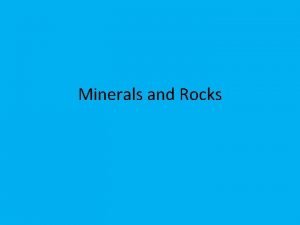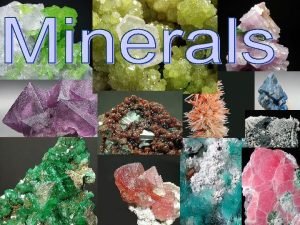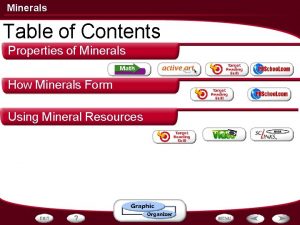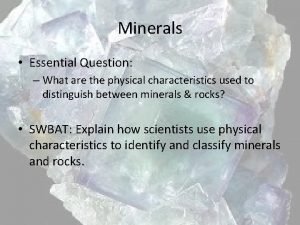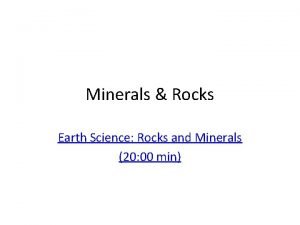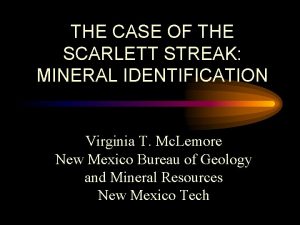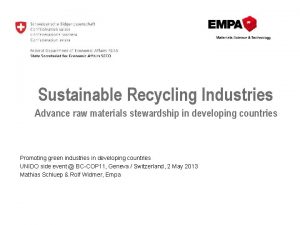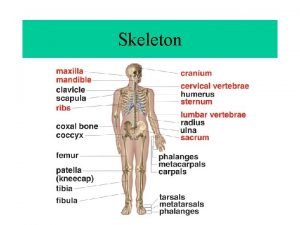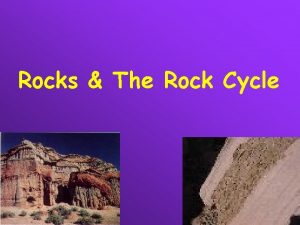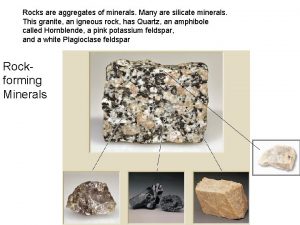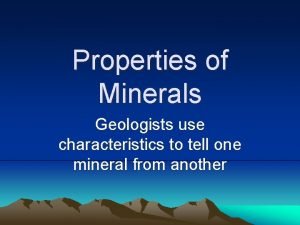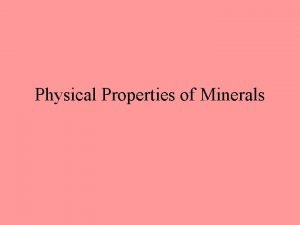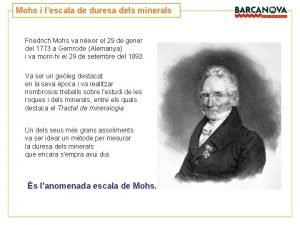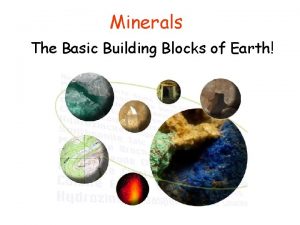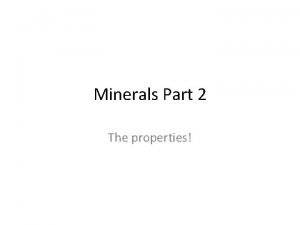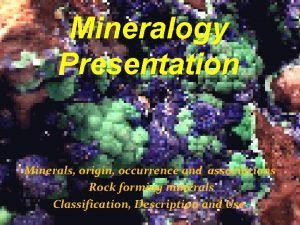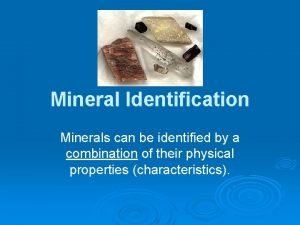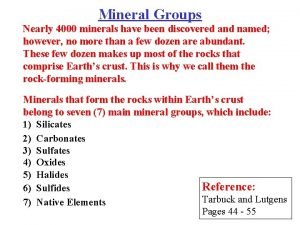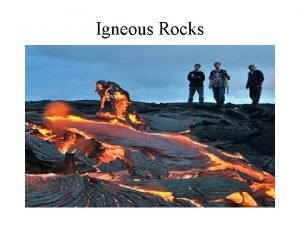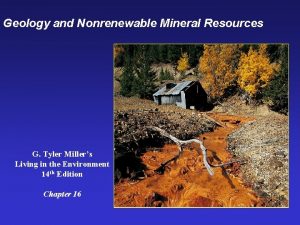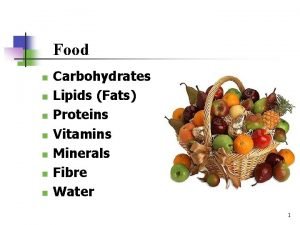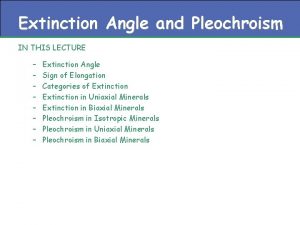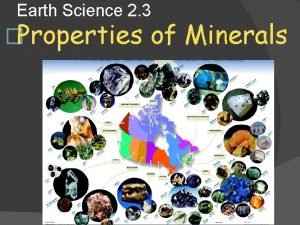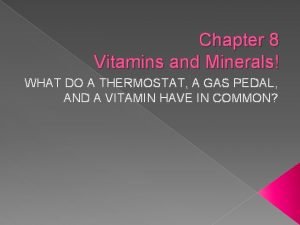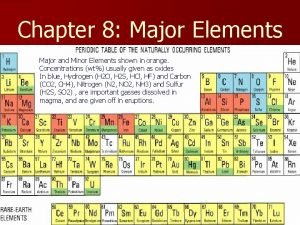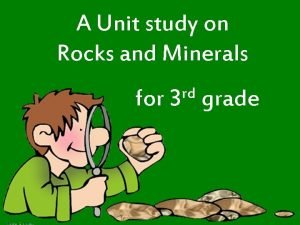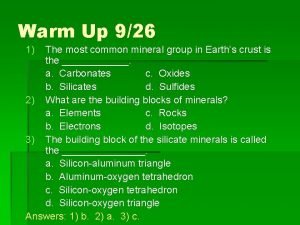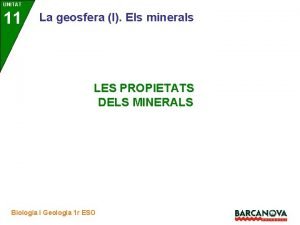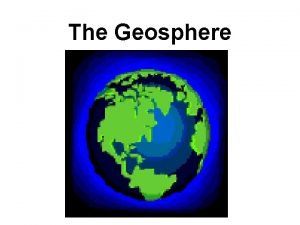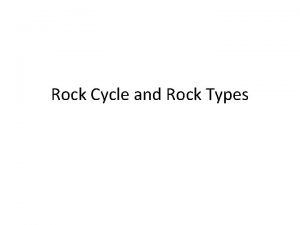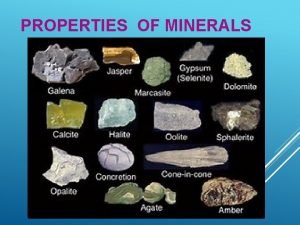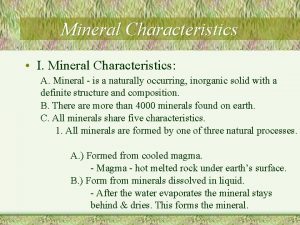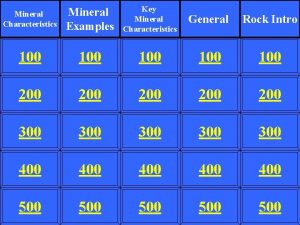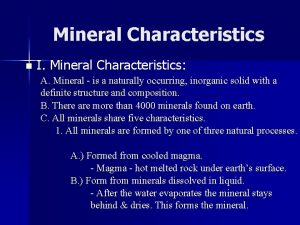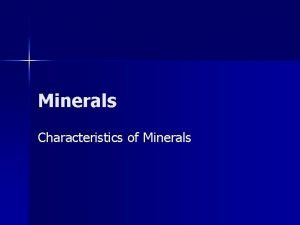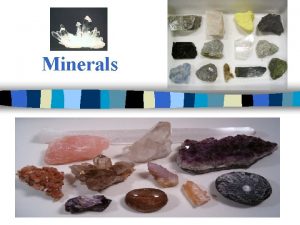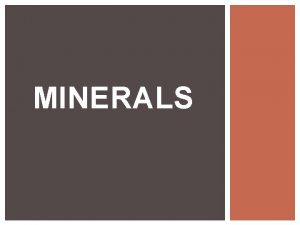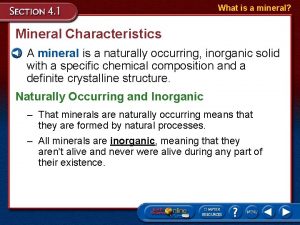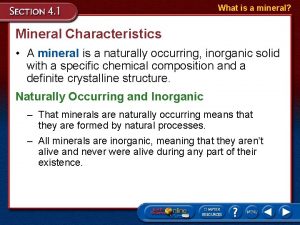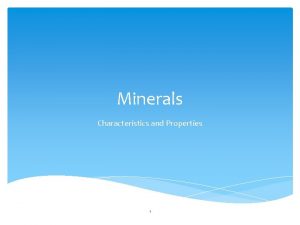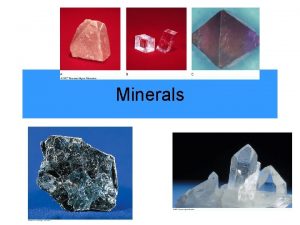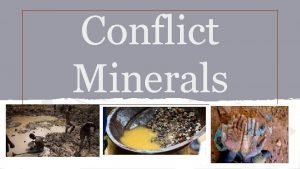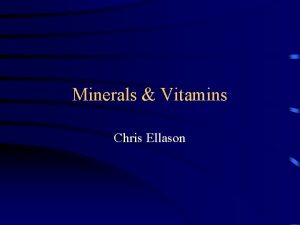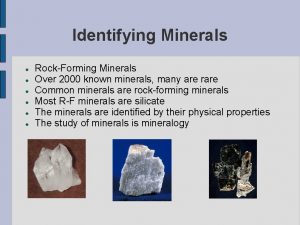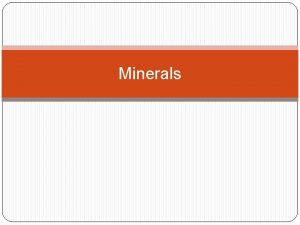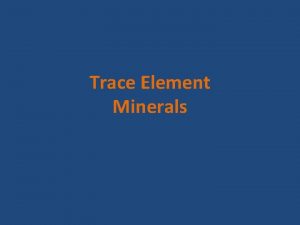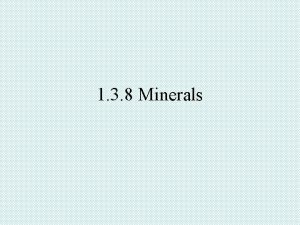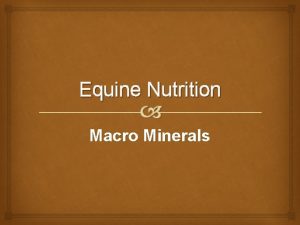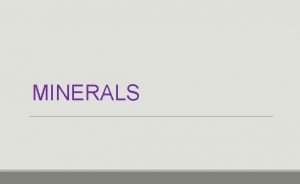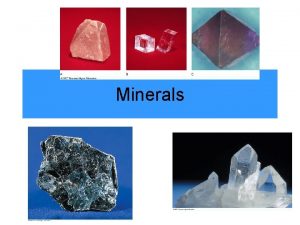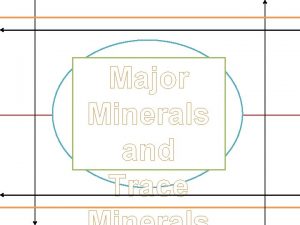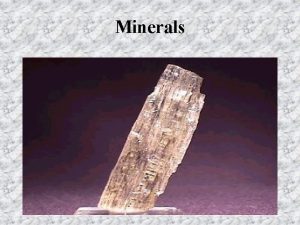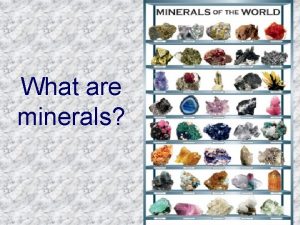Minerals A What is a mineral Mineral Characteristics



































- Slides: 35

Minerals

A. What is a mineral? Mineral Characteristics shared by all minerals: n 1. Natural – occurs naturally – NOT manmade

What is a mineral? n 1. Natural n 2. Inorganic – Is not alive – Was never alive

What is a mineral? n 1. Natural n 2. Inorganic n 3. Crystalline – Atoms are arranged in an orderly pattern

What is a mineral? n 1. Natural n 2. Inorganic n 3. Crystalline n 4. Definite chemical composition – Chemical formula – Si. O 2 is Quartz

What is a mineral? n 1. Natural n 2. Inorganic n 3. Crystalline n 4. Definite chemical composition n 5. Solid – Not a gas, not a liquid

How will we remember this? n Natural n Inorganic n Crystalline n Definite n Solid chemical composition

Mineral Characteristics shared by all minerals: Now I Can Define mineral. S! n Natural n Inorganic n Crystalline n Definite n Solid chemical composition

B. Physical Properties of Minerals n 1. Color – First impression – Not very reliable because lots of minerals can occur in many different colors

Quartz n Purple Amethyst

Fluorite • Clear • Blue • Green • Purple

Physical Properties of Minerals n 1. Color n 2. Streak – The TRUE color of a mineral – Color of a mineral’s powder

Streak Minerals with a hardness greater than “ 7” usually don’t create a streak on the streak plate because they are harder than the Porcelain tile (unless the streak plate is specially made).

Physical Properties of Minerals n 1. Color n 2. Streak n 3. Hardness – A mineral’s resistance to being scratched – Mohs Hardness Scale from 1 -10 Hardness depends on how “tightly packed” the atoms are

Mohs Hardness Scale Talc 2 Gypsum 3 Calcite 4 Fluorite 5 Apatite 6 Potassium feldspar 7 Quartz 8 Topaz 9 Corundum 10 Diamond 1 Softest Hardest


Physical Properties of Minerals n 1. Color n 2. Streak n 3. Hardness n 4. Cleavage – Splits along definite planes

“Cleav” = to split Cleaver


Physical Properties of Minerals n 1. Color n 2. Streak n 3. Hardness n 4. Cleavage n 5. Fracture – Breaks irregularly, jagged edges

Fracture

Physical Properties of Minerals n 1. Color n 2. Streak n 3. Hardness n 4. Cleavage n 5. Fracture n 6. Luster – How light shines off a mineral – Metallic or Nonmetallic

Luster n Metallic n Nonmetallic

Physical Properties of Minerals: Used for Identification (I. D. ) n Color n Streak n Hardness n Cleavage n Fracture n Luster

C. Special Properties n 1. Magnetism – Attracted to a magnet – Contains IRON, cobalt, or nickel

Special Properties n 1. Magnetism n 2. Double refraction – Looking through it, you see “double” – Ex. Calcite

Special Properties n 1. Magnetism n 2. Double refraction n 3. Fluorescence – Glows under ultraviolet (UV) light

Fluorescence under ultraviolet, UV light

Special Properties n 1. Magnetism n 2. Double refraction n 3. Fluorescence n 4. Phosphorescence – Continues to glow even after the UV light has been removed

Special Properties n 1. Magnetism n 2. Double refraction n 3. Fluorescence n 4. Phosphorescence n 5. Piezoelectric – Electricity is generated from Pressure – Example: Quartz

Piezoelectric (Pressure=Electricity)

Special Properties n Magnetism n Double refraction n Fluorescence n Phosphorescence n Piezoelectric

D. Identification Tests n 1. Hardness n 2. Streak (True Color) n 3. Acid Test – Use hydrochloric acid – Tests for carbonate (calcite)

Caves can form in rocks with calcite, like here in Harrisonburg! Acid in groundwater dissolves the calcite

 5 characteristics of minerals
5 characteristics of minerals Copper mineral group
Copper mineral group Uses of minerals
Uses of minerals Mineral streak
Mineral streak Minerals characteristics
Minerals characteristics Streak of minerals
Streak of minerals Conflict minerals
Conflict minerals Storage of minerals
Storage of minerals Primary vs secondary minerals
Primary vs secondary minerals Solid rock cycles
Solid rock cycles Rocks are aggregates of minerals
Rocks are aggregates of minerals Rock type
Rock type Difference between rocks and minerals
Difference between rocks and minerals Cleavage of chalk
Cleavage of chalk Color properties of minerals
Color properties of minerals Duresa minerals
Duresa minerals The building block of the silicate minerals is _____.
The building block of the silicate minerals is _____. Fracture minerals
Fracture minerals Flow chart of vitamins
Flow chart of vitamins Is a rusty nail metallic or nonmetallic
Is a rusty nail metallic or nonmetallic Nearly 4000 minerals have been named.
Nearly 4000 minerals have been named. Melted minerals
Melted minerals Economic minerals
Economic minerals Carbohydrates minerals
Carbohydrates minerals Symmetrical extinction
Symmetrical extinction Properties of minerals
Properties of minerals Chapter 8 vitamins and minerals
Chapter 8 vitamins and minerals Major elements
Major elements Difference between rocks and minerals
Difference between rocks and minerals Most abundant minerals in earth's crust
Most abundant minerals in earth's crust Propietats dels minerals
Propietats dels minerals Minerals in the soil
Minerals in the soil Composed mainly of minerals with blocky crystal shapes
Composed mainly of minerals with blocky crystal shapes Concept map about magma
Concept map about magma How a mineral reflects light from its surface
How a mineral reflects light from its surface Suzanna socked me sunday poem
Suzanna socked me sunday poem
